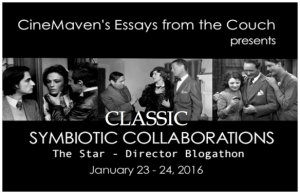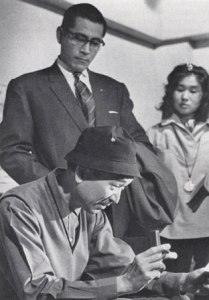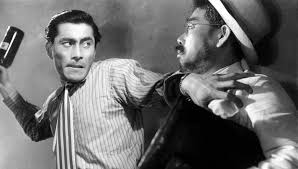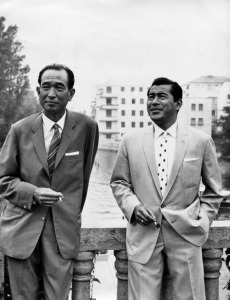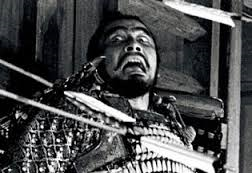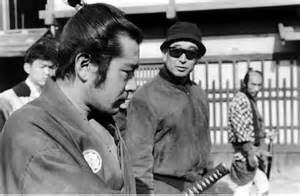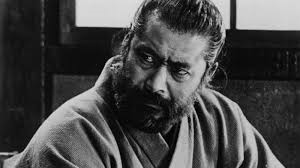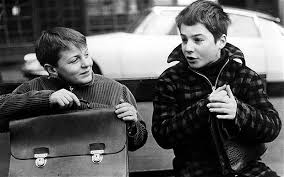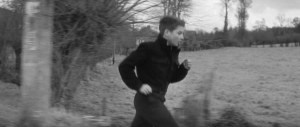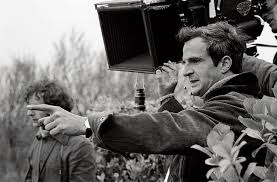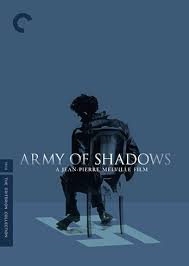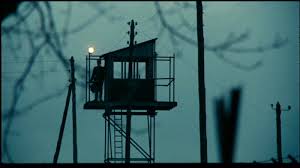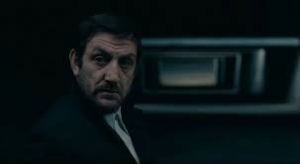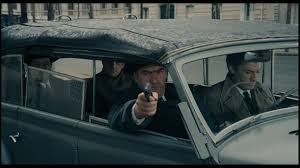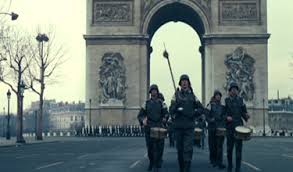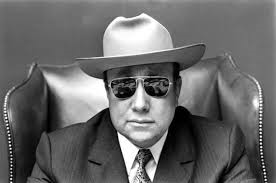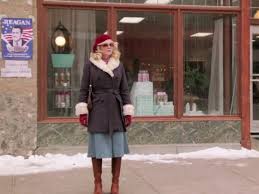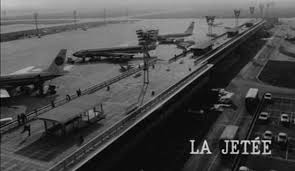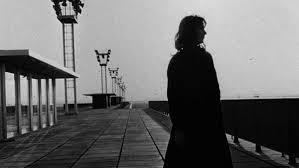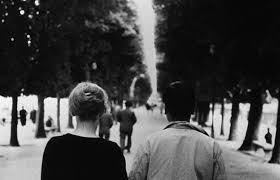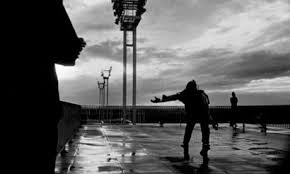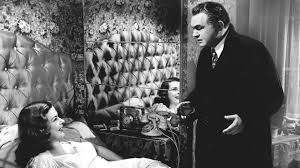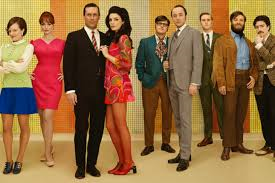For nearly as long as there has been cinema, directors have found actors who so succinctly covey the director’s vision of their characters that they work together over and over. From Griffith and Gish to Ford and Wayne to Scorsese and De Niro the combination of a great director and a great actor have given film lovers something to look forward to. Even if the result isn’t greatness, the result is always interesting. In the history of cinema no director-actor combination has been more artistically fruitful than Akira Kurosawa and Toshiro Mifune. Through nearly 20 years and 16 films they together produced a collaborative body of work without peer. Fifty years after their final film together was released, their combined efforts read like a laundry list of must see films of world cinema; Rashomon, Seven Samurai, Throne of Blood, The Hidden Fortress, Yojimbo, Sanjuro, High and Low, and Red Beard just to name the best regarded (which in case you weren’t counting is half their collective filmography). To appreciate their work together, I’ve chosen to focus on three films: their first together Drunken Angel, the first in which Mifune alone had top billing Throne of Blood, and their final film together Red Beard.
According to Donald Richie’s book The Films of Akira Kurosawa (the first English language volume on Kurosawa) Kurosawa called 1948’s Drunken Angel his first picture. “In this picture I was finally myself. It was my picture. I was doing it and no one else.” In truth it is Kurosawa’s seventh film, but it was the first he had full control of, and it was the first featuring Toshiro Mifune. The story of the relationship between an alcoholic doctor (Takeshi Shimura, Kurosawa’s great collaborator for the first ten years of his career) and a tubercular yakuza (Mifune) in postwar Tokyo, it touches on themes seen throughout much of Kurosawa’s films: master-student relationships, the Westernization of Japanese culture, the perils of capitalism. Though a very good film one sees both director and actor finding their way, not yet the icons they would become. Mifune seems as if he doesn’t yet have the confidence to fully realize the explosive nature that would come to characterize his acting in years to come. The bursts do come occasionally, but not with the energy and conviction seen later on in movies like Rashomon and Seven Samurai.
Kurosawa seems too to be just settling into his artistic vision. Though this would never be mistaken for an Ozu or Mizaguchi film, this is not yet the artist that would take the cinematic world by storm two years later after winning the Golden Lion at the 1950 Venice Film Festival for Rashomon. The dynamic editing and bravura set pieces that became his aesthetic hallmark in both period pieces like Seven Samurai and contemporary pieces like High and Low are lacking here. The one hallmark of Kurosawa that is here is weather. There is a Kurosawa downpour, no light rain, no pleasant breezes in Kurosawa. The rain comes in buckets, and the winds are monsoonal. Though filmed during the winter, one can feel the heat in a Tokyo slum during summer. And the weather always seems to reflect characters’ state of being or act as harbingers of change in his films. And in this, Kurosawa is all ready a master. In the Criterion Collection release of Drunken Angel, Richie’s commentary addresses this: “One could call this simplistic, the way that you could I suppose call the plots of these pictures simplistic. At least morally, at least philosophically. But you are not tempted to do so, it is done with such panache, and done with such finesse, and done with so little visible demand that you feel things, that you donate your feelings to Kurosawa. You go right along with him and don’t even realize it.”
By 1957’s Throne of Blood, both actor and director were fully formed. An adaptation of Shakespeare’s Macbeth transposed to 16th century Japan, Throne of Blood gives Mifune top billing alone. In films like Rashomon and Seven Samurai, Mifune may have stole the show, but he was just one of an ensemble and Takeshi Shimura was still Kurosawa’s top actor. Here Mifune alone is the star (though it can be argued that he himself was Mifuned by Isuzu Yamada who plays his wife). Playing Taketori Washizu (Macbeth), Mifune gives one of his most energetic and finest performances. Though many may find his acting over the top in the film, Kurosawa seems to have desired big performances from his male leads in his Shakespeare adaptations (see also Tatsuya Nakadai in Kurosawa’s late period masterwork Ran), and how Mifune delivered . The interplay of Mifune’s caged tiger turn and Yamada’s very subdued, more stereotypically Japanese performance are one of the film’s great strengths. As he paces back and forth mulling a decision, she sits placidly and moves him toward his fate (remember, it is Macbeth). Mifune’s intensity went beyond his pacing and line readings. In Stuart Galbraith IV’s dual biography on Mifune and Kurosawa The Emperor and the Wolf, Takeshi Kato who played a bit part in the film, relayed this anecdote; “Three cameras shot Mr. Mifune coming at me with a sword. I put a piece of wood up my sleeve for safety when he stabbed me. However, Mr. Mifune was so quick and powerful that he broke right through the wood and really stabbed me!” For Throne of Blood and his two other 1957 films, Mifune won the Manichi (annual film awards sponsored by a Japanese newspaper conglomerate) Award for best actor.
For Throne of Blood, Kurosawa took the combination of cinema and theater past just adapting The Bard. Both the soundtrack and make-up are heavily influenced by the Japanese Noh theater, a strange combination as Shakespeare’s plays were for the masses and Noh the entertainment of the Japanese aristocracy. However Kurosawa makes the disparate elements work. Mifune’s make up makes his a face appear more and more like a mask traditionally used in the Noh. Despite the theatrical pedigree Kurosawa had no interest in merely filming a staged play as was so often the case in Shakespearean adaptations, such as those of Laurence Olivier. Kurosawa was insistent on doing more than this, and more than was the norm for Japanese historical dramas, “I’ve always thought the Japanese jidai (period film) is historically uninformed. Also, it never uses modern film-making techniques. In Seven Samurai we tried to do something about this, and Throne of Blood had the same feeling behind it.” And Kurosawa achieved his goal. Axial cuts, quick cut pans, multiple cameras, wipes to break scenes, and telephoto lenses, these are his modern techniques. And recognizable to fans of Kurosawa as trademarks of his style through the 60s, and in the case of the axial cuts, lenses and cameras, beyond. Throne of Blood was also a sneak peek of what was to come….in thirty years. This was Kurosawa’s first film that ends on a note of hopelessness, a note that wouldn’t be seen again until his “late period” 70s and 80s films.
In scholarly accounts of Kurosawa’s films (Richie’s book and Stephen Prince’s The Warrior’s Camera are particularly valuable in this area), the word didactic often comes up. In his films, Kurosawa does seem to be trying to instruct his audience and we do see master-pupil relationships in his films. Red Beard was his only film where this relationship is the subject of the film. Sixteen years had passed since Drunken Angel when filming began. The young gangster being schooled by the drunk doctor is now an elder doctor teaching a wealthy young doctor at a medical clinic for peasants during the Tokugawa period. The relationship between the doctors though, is one of unlearning. Red Beard (Mifune) teaches the young doctor Yasumoto (Yuzo Kayama) by showing that sometimes you must forget what you’ve learned in theory, to make a difference practically. Because of television’s lessening of film audiences, Kurosawa “wanted to push the confines of movie making to their limits.” Both Richie and Prince find this film to be unique in Kurosawa’s oeuvre. Richie saying “the plot is as complicated as anything in Dickens, but there is no overriding form. The film, to be sure, is vaguely cyclical.” Despite not going so far as the French or Japanese New Wave directors were in demolishing classic film form, for a man whose films had arrow straight plots, this was a departure. As was the story which moved away from the real world groundings typical of Kurosawa. Per Stephen Prince, “Unlike the films of Ozu, Bresson, and Dreyer, which, it has been suggested (by Paul Schrader, my notation), belong to a tradition of ‘transcendental style,’ Kurosawa’s work has always exhibited an exclusive commitment to the surfaces of the material world. Red Beard, however, is the exception. This is a deeply spiritualistic film.” In the years that followed, Red Beard remained the outlier. As changing tastes, difficulty obtaining financing, and a failed suicide attempt led to Kurosawa trading spiritualism for nihilism.
In his work with Kurosawa, Red Beard is a bit of an outlier for Mifune as well. His performance is far more subdued than seen in any of the other period pieces done with Kurosawa. And for the first time in over ten years, Mifune was not the focus of the film. Red Beard may loom over the film, but it is the young doctor who gets more of the screen time. Instead of the animalistic Mifune of the 50s or the swagger of his wandering ronin in Yojimbo and Sanjuro, we get closer to middle aged man Mifune was in the mid 60s. Now being the master in this film, maybe what happened next was inevitable. Though the split between the two men was never explicitly detailed by either, the common story is this: The two year shoot for Red Beard, during which he could do no other films, left the financially strapped (a failing production company and bad decisions) Mifune questioning further collaborations with Kurosawa. And Mifune taking work in lesser films left Kurosawa cool to more films together. In Galbraith’s biography he says “the artistic benefits of working with Kurosawa were outweighed by the overwhelming business concerns that constantly plagued him (Mifune)” and that “Kurosawa felt betrayed and refused to understand how the actor could appear in inferior films.” And thus ended what the British critic David Shipman called “The greatest actor-director partnership in film history.”
The Symbiotic Collaborations Blogathon is hosted by the CineMavens Essays from the Couch. Go read all the great posts by a higher caliber of writer than myself.
